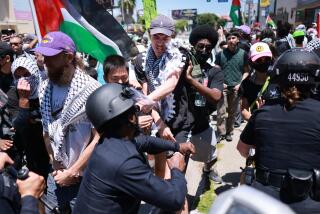He went on like that, using terms I hadn’t heard in 20 years. . . .
It was just a coincidence, not news as it is usually understood. But the irony of this accidental overlapping of events was too deep to pass over without comment.
The situation was this: The congregation of Temple Sinai in Glendale had asked two prominent Arab leaders in Los Angeles to attend a Friday service to talk about discrimination against Arabs in America. Implied was the idea that the feelings between Arab and Jew may contain some group prejudice and that, by meeting face to face in a harmonious setting, the two groups could cleanse their own emotions.
As it happened, this was the week that Arab rioting and Israeli repression broke out in the Gaza Strip. Then, after midnight of the Sunday before the service, a vandal struck in the dark, spray-painting the temple walls with slogans and insignia. The exact words have been published already and don’t need repeating. They were bitter, ugly.
Even the quick arrest of a Highland Park man reputed to be a member of a white supremacist organization did not forestall the avalanche of recriminations, particularly in the news media, linking the event to racist goblins in Glendale’s past.
Glendale, it is true, was once an almost exclusively white town that took no pains to counter its reputation for hostility to minorities.
Times have changed, however. A look at enrollment in the Glendale schools today shows how much. After steady increases for 15 years, immigrant groups from Latin America, Asia and the Middle East make up 52% of Glendale students. They speak 50 languages and dialects. One-fourth of the student population is Hispanic. Only blacks, of whom there were four in 1970 and 65 today, remain relatively scarce.
Yet racism is hard to vanquish.
And so the idea of one of Glendale’s minority groups setting aside its animosity for another to examine the feelings that affect them both was eye-catching. That this self-examination should be marked by an overtly racist assault made it compelling. I decided to attend.
Unexpectedly, on the night of the service, I was an hour early. The temple was still dark. I wandered a couple of blocks down Pacific Avenue until drawn in by the friendly facade of a neighborhood saloon. Inside, a few men played pool, and two men and a woman at the bar watched TV.
I sat down next to a man who had no hair except gray stubble above the neck. He drank beer from a mug and commented on the game, a good one between the Lakers and Celtics. It came down to the last three seconds, Lakers down by a point, in possession. Time out.
Over commercials, the bald man offered his analysis of the coming play.
“One nigger’s going to throw the ball to another nigger,” he said, smirking.
What really happened was that Magic Johnson took a pass, turned and tossed the ball in a graceful arch off the glass and into the basket.
“Yeah! Spear chucker!” one of the pool players screamed, jumping up and down. “Jungle bunny! Worth every penny.”
He went on like that, using terms I hadn’t heard in 20 years--not even in blue-collar bars--until his excitement wore out.
Ugly words. They and others like them came from just a handful of people, perhaps not representative of the city. But they lay very near the surface in what had moments before seemed a genteel and friendly neighborhood. I decided it was time for temple.
Carole Meyers, the rabbi of the Reform congregation, greeted me at the door with a handshake.
About 100 people spread out in theater-style seats that swept up toward a stage and two tall, arched tablets inscribed with Hebrew letters.
The cantor sang ebulliently: “Light one candle for the strength that we need to never become our own foe. . . . Don’t let the light go out. It’s lasted for so many years.”
Later, he and the rabbi opened the tablets and took out the scroll of the Torah. She carried it down the aisles, letting everyone touch it. Most reached out their prayer books, and then kissed them.
After the service, the two Arab guests walked forward. From the pulpit, each gave a short talk. Cheryl Faris, an attorney, listed the four roles given Arabs in the movies--the rich oil sheik, the terrorist, the camel rider and the belly dancer.
Michel Shehadeh, a journalism student, was one of seven Palestinians arrested by the Immigration and Naturalization Service in January, but released after a plan to deport them got bogged down in court.
“We were arrested because we were a test case for a bigger plan,” Shehadeh said.
The government, he said, wanted to be able to deport Arabs at will.
“To be honest with you, we are scared and we want your help,” he said.
Later, the congregation moved to the social hall behind the chapel to share cakes, coffee and questions.
Some of the questions were gentle, others tough. Someone asked Shehadeh to comment on Arab terrorism. He said he was against all terrorism, but beseeched his audience to understand that, to displaced Palestinians everywhere, the Palestine Liberation Organization is the only representative government.
Although few in the room could have listened without discomfort, not a speck of ill will showed. Some resolved to join Jewish-Arab discussion groups.
On balance, it was not a bad night. A small amount of prejudice may have been vanquished.
More to Read
Sign up for Essential California
The most important California stories and recommendations in your inbox every morning.
You may occasionally receive promotional content from the Los Angeles Times.











